|
|||||||||
|
|
Tanks of World War 1World War 1 saw the invention and first use in combat of tanks, self propelled armoured vehicles equipped with guns. The other combatant nations such as Italy, Austria, Russia, France and the United States also developed armoured vehicles ranging from tanks to armoured cars. The concept of protecting troops by sheltering them inside a mobile shell or tank was not a new idea in World War 1. The ancients had tried varieties of this idea centuries before, but had been limited by the lack of a means of rendering these "tanks" self propelled. 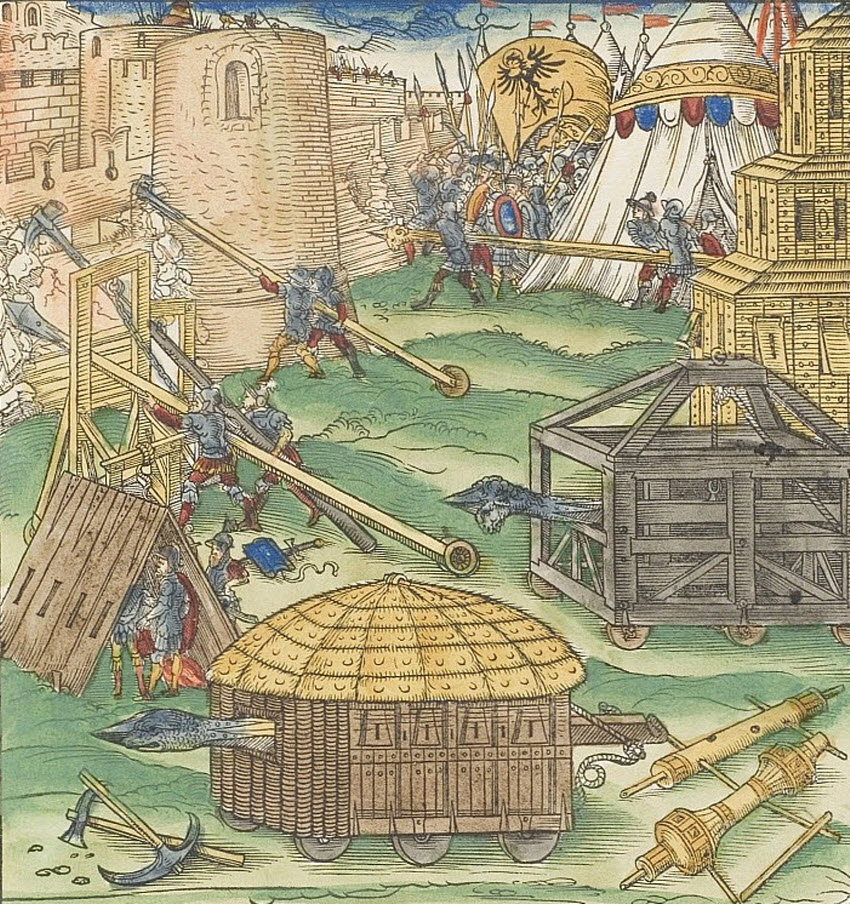 The origins of the tank as a moveable protective shell or fort for troops can be traced back to medieval and ancient siege warfare. In order to reach the walls of besieged cities under fire from the defenders, the attacking armies would often build ingenious moveable fortifications such as siege towers and covered battering rams. These mobile forts were usually wheeled and were moved by human muscle. They can be considered the ancestors of modern tanks in that they incorporated many of the concepts present in armoured vehicles: they were mobile, provided protection for the soldiers inside, and were often mounted with an offensive weapon such as a catapult, battering ram or hook. However they were only meant to travel short distances and were not the land ships which Leonardo Da Vinci had sketched a concept for a tank, complete with sloping armor in his notebooks. In many ways Da Vinci's model was ahead of its time, and might even have proved superior to World War 1 tanks had it ever been built. The Da Vinci design had sloping armor (to deflect the impact of artillery shots) and a rotating gun turret. Lacking the concept of an internal combustion engine, Da Vinci's tank was to be powered muscle power from soldiers or animals. Like many of Da Vinci's ideas it was never built. 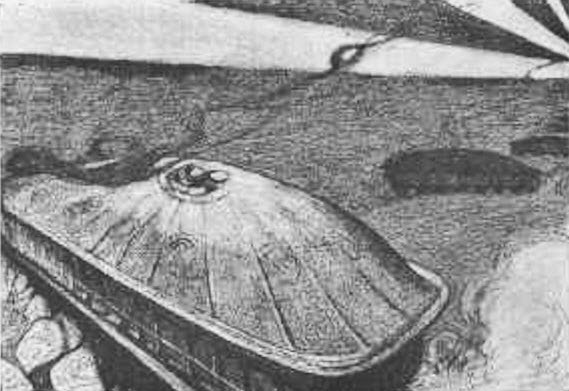 In more modern times, many writers and inventors conceived the concept of a land battleship. In 1903 the science fiction writer H.G. Wells, who also predicted the concept of arial bombardment, wrote a short story called the "Land Iron Clads" which described large self propelled land ships carrying troops and artillery. His concept resembled more closely the idea of a battleship on land than a modern tank. In the years just before the Great War, several concepts were proposed that presaged the tanks. Shortly before the war Austria developed a wheeled armoured car, but its effectiveness was limited because it could not travel off road. And various French and British engineers proposed building armoured trains or mounting steel boxes and guns on top of tractors to give artillery cover and mobility. 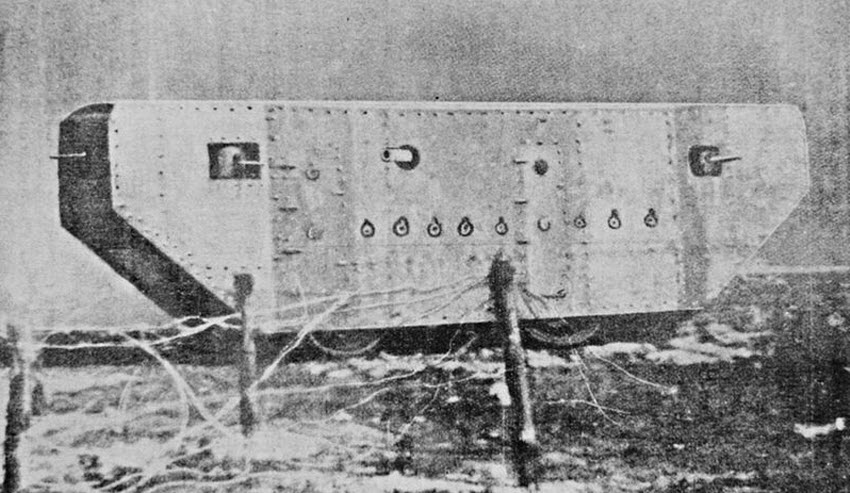 A French "Land Ship Tank" These ideas were largely ignored until World War 1 when military leaders on both sides began looking for ways to protect their troops and break the deadlock which was developing on the fortified front lines. In a concept reminiscent of HG Wells' idea of a Land Iron Clad, the French experimented with a "Landship". The Frot-Laffly landship was an early experimental French tank built in 1914 on the chassis of a Laffly agricultural tractor. It predated the British tank designs by almost a year. It was equipped with a thin steel armor and various turret mounted guns. These guns could be rotated but could generally only shoot from one side, requiring more guns and crews to be placed on the front, back and sides of the machine. The land ship proved unsatisfactory during testing and production was abandoned. Various other models were experimented on by the French and British, all using as the starting point a tractor chassis. The first operationally successful tank was the British Little Willie prototype, which would serve as the basis for the British Mark 1 Tank. The British Mark 1 Tank was the first combat operational tank and saw action on the Western Front on September 15 1916 against the Germans during the Battle of the Somme. 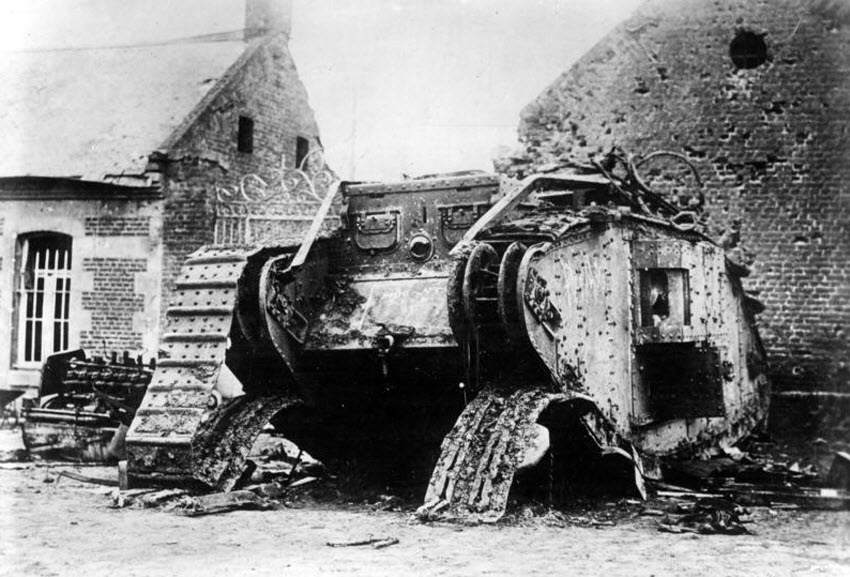 A Destroyed British Tank Hit By German Fire One of its main innovations was the use of continuous tracks which allowed it to navigate rough terrain better than a wheeled vehicle. It was oddly shaped like a rhomboid, which gave it a slightly lower center of gravity than competing German and French tanks. But its design meant that it could not mount a gun turret on top, like modern tanks, but instead had gun emplacements and machine gun ports on the front and side. Its tracks were exposed from the front and side and were vulnerable to enemy fire. In some ways, the first tanks of World War 1 were actually more primitive than Da Vinci's idea. Their main improvement was that they were equipped with an internal combustion engine and were thus truly mobile. But in terms of their design, they were not much better than metal boxes. Their armor was not sloped. which meant that its steel plating took the full impact of shells and gunfire, and its cannons were not mounted on rotating turrets which meant that in order to aim, the whole tank had to shift position. 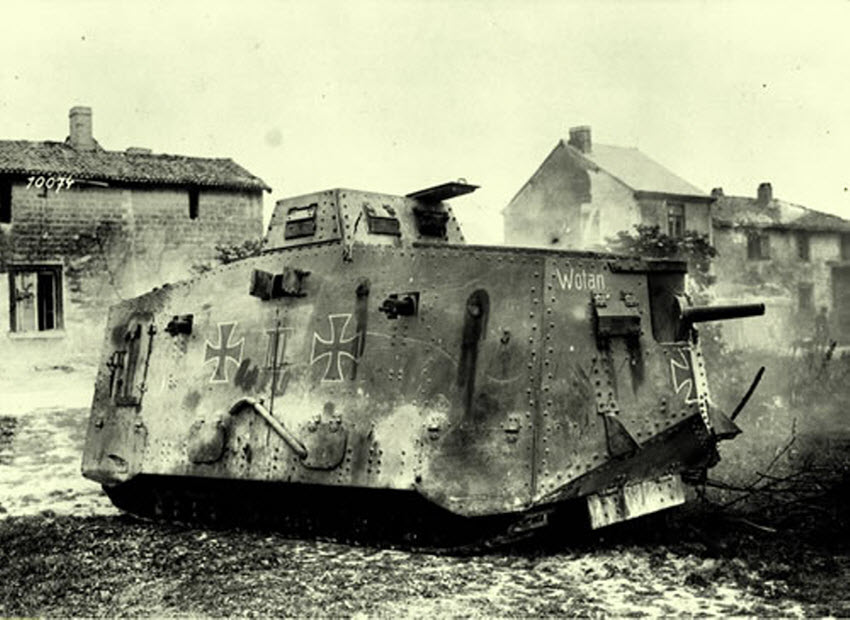 German World War 1 Tank The German and French tanks embodied the same design flaws. Copied from the British design, these tanks were essentially metal boxes. The models differed in size, and the number of machine guns mounted on them, but they were essentially the same. Some tanks, particularly the Germans ones, were incredibly large which gave them a dangerously high profile and made it easier for enemy gunners to hit them. It also gave them a high center of gravity, which resulted in many tanks tipping over while traversing rough terrain. The Germans countered this new weapon by introducing anti tank rifles that could pierce the British armor, and developing tanks of their own. The first tank versus tank battle in history took place on April 24, 1918 when three British tanks engaged three German tanks. The main producers and developers of Tanks during world war one were France and Germany, who produced the greatest number of tanks as well as the most technologically successful. Germany produced relatively few tanks, and mainly relied on captured British and French tanks. The United States fielded a tank corps, but it was equipped mainly with British produced tanks and did not start mass producing its own tanks until just before the war. Italy fielded a small force of Fiat tanks, and other countries such as Russia also worked on developing tanks but they never went into production, Pictures of the early Russian tanks show a revolutionary low profile and sloped armor, which would have proven very effective if they had reached the front lines. 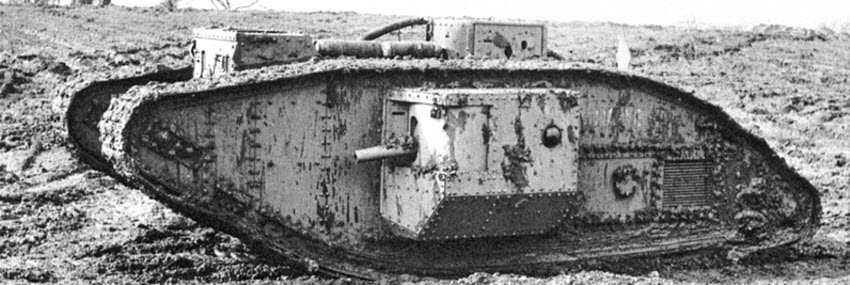 British World War 1 Tank (a Mark V) During the war, most tanks were employed on the western front. A few British tanks were lent or given to White Russian forces following the Russian Revolution and a handful of tanks also engaged the Ottoman Empire during the battles for Gaza towards the end of the war. The greatest armoured successes were enjoyed by the British when a unit of British tanks conducted a deep penetration of German lines during the Battle of Amiens in August 1918. However neither side produced enough tanks, nor employed them effectively enough, to make a significant difference in the outcome of the war. Tanks did not put an end to trench warfare or do away with costly massed infantry assaults. However, the lessons learned by the combatants would form the basis for the armoured warfare of world war 2. See Also:
| ||||||||
